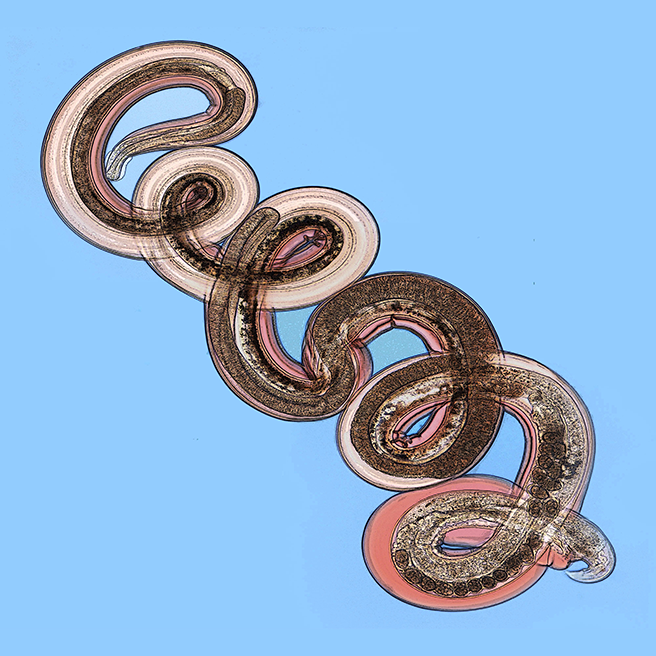Parasitic Helminths May Soon Be Used To Protect Organ Transplants
As demand for organ transplantation has increased, medicine has tried to increase the donor availability by using donor organs of decreased quality, or those considered to be less of an immunological match. This increases the need to protect the new transplanted organ from the recipient’s immune system, as the immune system sees the organ as an invader and ramps up the immune system to intervene. Current drugs used to protect the organ from the immune system have serious side effects that decrease the quality of an individual’s life. Into the picture comes parasitic helminths. Parasitic helminths have developed the capacity to modulate the host’s immunoregulatory mechanisms in order to lower the hosts ability to eradicate the parasites. What if we could use parasitic helminths, or substances these parasites make to regulate the immune system of organ transplant patients in such a way that the Organ Transplants are Protected and the patient no longer needs to take toxic immunosuppressant drugs? Researchers are examining this and the studies find both helminths as well as by-products from helminths are useful to prevent organ transplant rejection. Some of the factors that are shown to change organ survival are how long the live helminth infection is in existence, the type of organ transplanted and the type of helminth used.
Issues With Organ Transplantation Drugs
The long-term survival rate of organ transplants are associated with the management of acute rejection episodes. This is accomplished with immunosuppressive drugs.
Immunosuppression treatment for solid-organ transplants carries a lot of risks, including toxicity, infections, and cancer.
The living-donor kidney transplant survival time of the organ in 2014 was 11.9 years which is not much more than the 11.4 years it was in 2005.
Searching For Other Methods To Decrease Organ Rejection
Studies have shown T-regulatory cells mediate organ transplant tolerance. However, the attempts to use T-regulatory cells in research has come with issues that medicine has not been been able to eliminate. So far this is an avenue that can’t currently be used. One, of the suggestions for enhancing Treg populations in the body has been through use of helminths which are known to infect about 25% of the world’s population and appear to increase T-regulatory cells. While the lethal protozoal parasites cause inflammatory reactions, long-lived helminths are known for down-regulating the hosts immune system which protects them from elimination and also decreases the inflammation more common with other parasites.
Helminths Help Down-regulate an Overactive Immune System
In experimental studies the ability of parasites to down-regulate the hosts immune system has been shown to have positive response for individuals with autoimmune, or up-regulated immune systems, such as in the case of inflammatory bowel disease, rheumatoid arthritis, type I diabetes, and allergic airway inflammation. Other diseases showing promise with helminth infections are multiple sclerosis and Crohn’s disease. In countries with lower helminth infections, we know there is greater prevalence of autoimmune disorders and allergies. For additional information on how helminths are used for autoimmune disorders, check out the article Parasitic Worms To Treat Autoimmune Conditions.
Specific Studies On Parasitic Helminths And Protection of Organ Transplants
Liver Transplants
It has been noted that human patients with liver transplants that were naturally infected with the metacestode Echinococcus multilocularis had significantly improved tolerance to their transplanted organs.
Heart Transplants
A rat study showed rats with Echinococcus multilocularis infection in hearts given to them as heart transplants had half the heart transplant rejections than the rats without Echinococcus multilocularis infections. There are studies with liver and heart transplants as well as skin transplantation in rodents while infecting them with a variety of parasites. They all report prolonged survival of the transplanted organs.
Mice with heart transplants who were inoculated with Nippostrongylus brasiliensis have been shown to still have organ protection even long after the mice cleared the infection.
Skin Transplants
Skin grafts are notorious for being rejected quickly. In humans with skin grafts, a control group of 16 people was studied with a group given skin grafts from donors with Schistosoma mansoni (a fluke) infection (19 patients). Just in case you are wondering, they did not infect them with the flukes, the skin grafts came from people with flukes and due to the shortage of donor skin available for grafts, people will accept such grafts. It turned out that all of the control group rejected their grafts in less than two weeks and in the Schistosoma-infected patients 16 patients went more than twice as long without rejecting their grafts, while 3 patients still had not rejected the grafts at 60 days.
Additionally, research in mice found the mice needed to be infected with Shistosoma for a full 60 days for them to tolerate their grafts for an average of 50% longer than the controls. There was also an association with the number of live parasites still remaining and graft survival.
Organ Transplants Protected By Parasitic Helminths By These Mechanisms
This research has expanded out into the use of a variety of helminths and it appears the protection is afforded to all transplanted tissues. So far, all parasites studied appear to have an immune system dampening effect. Additionally, secretory products from helminths have been studied and found to have similar effects.
Researchers have noted an increase in Th2 response and decrease in Th1 response. The Th1 response thought to be largely responsible for organ rejection.
Helminths have been found to modulate the hosts immune system in a variety of ways. They increase the number of Tregs available (immune cells that regulate the immune system and are important in decreasing an overactive immune system), enhance immunosuppressive activity in B-cells, as well as modify dendritic and macrophage populations.
Future Use of Helminths In Organ Transplantation
Researchers are discussing the possibility of using parasitic helminth therapy prior to live donor transplants to create a more tolerable environment at the time of the transplant. When you compare the helminth therapy with the current drug therapy available to transplant patients, it appears the helminth therapy may provide a safer, more effective option, however more research is still needed.
For Those Who Want Additional Details On the Immune System Response
Helminths, induce what is being called a modified Th2 immune response, characterized by the presence of cytokines IL-4, IL-5, IL-13, and IL-10, antibody isotypes IgG1, IgG4, and IgE, and expanded populations of eosinophils, mast cells, basophils and M2 macrophages. There is also increased anti-inflammatory cytokines such as IL-10 and/or TGF-β, and in many cases, parasite-specific immune suppression.
General responses to helminth infections may differ from Th2-dominated allergic reactions in that they induce a stronger regulatory component but also a weaker Th17 component. Researchers also note a diminished IL-5 and IL-13 secretion in this modified Th2 response.
The Th2 response is thought to be a response of the host in efforts to regulate the tissue damage caused by parasites at they move through the host. This is thought to have created an active co-evolution between the host and parasite. Studies show the Th2 response appears to be due to pro-inflammatory cytokines released from damaged epithelial cells causing activation of M2 macrophages and Th2 cells responding to the need to repair tissue by providing extracellular matrix proteins. The parasites that are successful in life, learn to regulate the Th2 immunity of their host and also appear to lower the inflammatory Th17 reactions.
Peoples Reports On Use of Helminths For Various Diseases
To see data on how people are self-treating with helminthic therapy, mostly for autoimmune disease, go to https://helminthictherapywiki.org/wiki/index.php/Helminthic_Therapy_Wiki.
The photo above is courtesy of J. Claire Hoving, CC BY 2.5
Send To Friends And Family Who Would Want To Read This!


